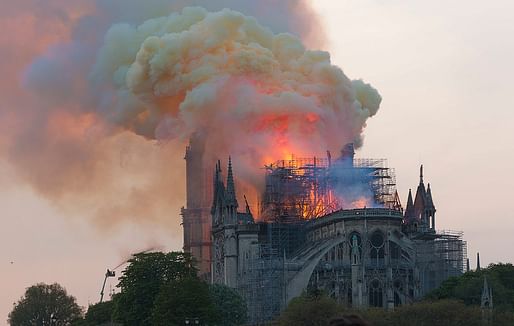

Notre Dame is not stable and urgently needs reinforcing. [...]
The collapse of a part of the vaults has severely reduced the safety of its structural system, which, in the case of a Gothic cathedral, does not rely on the heavy mass of the walls, as in classical architecture, but on discharging weight through clustered columns, external flying buttresses and counter-supports—a structural “exoskeleton” that until now has been extremely effective and resilient.
— The Art Newspaper
A new assessment of the Gothic cathedral's structural system after the devastating April 15 fire shows that the stability has been severely weakened by various factors and warns that the walls could now fail to withstand strong wind gusts.
"Paolo Vannucci, a mechanical engineer at the University of Versailles, has modelled the engineering of the structure," reports The Art Newspaper, "and shown that the walls of Notre Dame could collapse under the pressure of wind speeds higher than 90km per hour, while before the fire they could withstand winds of up to 220km per hour, so they urgently need temporary supports."
90 kilometers per hour is only 55 miles an hour. That must be with the wind hitting the flying buttresses before hitting the walls and forcing the walls inward where there is no external support now that the roof is gone. Seems fixable with temporary bracing across the roof opening but I am sure it must be more complicated.
All 4 Comments
Quick, fill it with Jell-O Pudding!
No vanilla. If he has to, Jesus will brace those walls with the Holly Cross and then cover it with glass.
How many layers of thoughts and prayers do we need in order to keep it from collapsing? I guess the non-existent invisible big guy upstairs is using unpaid interns to collect his mail again.
90 kilometers per hour is only 55 miles an hour. That must be with the wind hitting the flying buttresses before hitting the walls and forcing the walls inward where there is no external support now that the roof is gone. Seems fixable with temporary bracing across the roof opening but I am sure it must be more complicated.
you have to add the force/weight of the buttresses that are supposed to be a reaction to the roof pushing out, it's an angled vector.
Seems like temporary horizontal bracing at the top of a wall where the flying buttress attaches across the roof void to a similar spot on the opposite wall would transfer wind loads to the buttress on the other (downwind) side of the church.
Right. I'm not an engineer, but it seems to me that without the horizontal members of the roof [if indeed they are gone] preventing the wall from collapsing inward, the previous compression forces on the butresses are now tension forces for which the butresses were not designed.
Amazing to see how architects have reacted to this tragedy. Meanwhile Hudson Yards shows what the biggest architects can do with a blank slate. A sad showing for our profession.
There were renderings 24 hours later...the new ambulance chasers have arrived
Truly unfortunate that so many hacks got the most media attention.
Block this user
Are you sure you want to block this user and hide all related comments throughout the site?
Archinect
This is your first comment on Archinect. Your comment will be visible once approved.